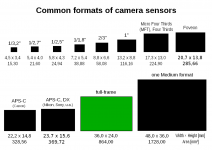It's no secret that smartphones have decimated the sales of DSLRs, but standalone camera hardware could be taking another major step toward obsolescence relatively soon.
Go to post
Go to post
Exactly. But, the naysayers (scared photographers and DSLR/Mirrorless manufactures) fearmongering claimed for years that it wasn't "physical" possible. Well...Honestly if you had an older DSLR and were not keeping up with upgrades over the past few years. Other than better telephoto performance and lens options... Smartphones have outpaced DSLR for casual users a LONG time ago.
What do you mean outpaced? Even a 10+ year old entry level DSLR outperforms smartphones in anything but the megapixel value, which is about the least important metric when it comes to digital photography.Honestly if you had an older DSLR and were not keeping up with upgrades over the past few years. Other than better telephoto performance and lens options... Smartphones have outpaced DSLR for casual users a LONG time ago.
You mean there's more to photography than megapixels?What do you mean outpaced? Even a 10+ year old entry level DSLR outperforms smartphones in anything but the megapixel value, which is about the least important metric when it comes to digital photography.
Compact cameras are in no way comparable to DSLR quality. Even bridge cameras were a world away from actual DSLRs in the 2000s, and compact cameras are two steps bellow that even. I know, I went through the entire ladder.My in-laws still use a Sony digital camera from, like... 25 years ago? It eats AA batteries like there's no tomorrow, you can't get the memory cards for it anymore. But they swear by it. It might be 4MP? Not sure.
What do you mean outpaced? Even a 10+ year old entry level DSLR outperforms smartphones in anything but the megapixel value, which is about the least important metric when it comes to digital photography.


Ease of use, zoom functionality with no additional purchase, portability, quality for the average consumer.What do you mean outpaced? Even a 10+ year old entry level DSLR outperforms smartphones in anything but the megapixel value, which is about the least important metric when it comes to digital photography.
Ease of use, zoom functionality with no additional purchase, portability, quality for the average consumer.
Unless you want timeless photos done at an event, or are into photography in general then really all of the hassle around buying a DSLR camera, lenses, additional batteries, stands, and everything else is just not worth it.
I invested a few grand (so CLEARLY not high end.) into my wife's DSLR interest some 8+ years ago. Now she doesn't even care about that because the newest phones take photos better than her skill could eek out of a a DSLR without needing to 'train up'. That and when you have the phone to play with the modern phones have many ways to emulate the abilities of a DSLR. Hell you can even take pictures in .RAW and do extended exposures and all of that fun stuff. + all of the stuff having it built into your phone includes.
So yea... my few years ago is 8 ish years ago. And my Note 20 Ultra with it's 100 bla blah blah and built in 5x telephoto lens and umpteen other features makes her old DSLR with several lenses, tripod, extra batteries and memory cards, and so and and so on... seem old and and antiquated.
I have ZERO doubt someone with skill using the camera could take amazing pictures. But when we want pictures these days on the fly it's to preserve memories. Not to get the most accurate light/color soaked images that have perfect reality captured.
So I'll say again. A DSLR from a few years ago. (NOT cutting edge even then.) is outpaced by modern phones. Add in additional functionality and modern phones leave many DSLR and newer cameras in the dust.
Thing is DSLR cameras still are not perfect. If you really want to take a picture that looks better than a smartphone, get ready to not just buy a DSLR, but also lamps, reflective screens, stands, lenses, and much more.
Newer phones can "fake" exposure, lighting, color balance, white balance, contrast, etc via AI filters.
Besides what's a perfect DSLR picture when you fill it with snapchat filtersYeah, but nothing beats the real thing. Those AI effects always look kind of chintzy.
It's what people know, even though the only company still producing new models is... Pentax. Who never could figure out things like 'autofocus on a moving subject'. Bulletproof cameras though, and at more accessible prices than those of competitors!Also, why are we talking about DSLR's?
These things help cell phone cameras too - to the point that you can get strobe triggers for phones.Thing is DSLR cameras still are not perfect. If you really want to take a picture that looks better than a smartphone, get ready to not just buy a DSLR, but also lamps, reflective screens, stands, lenses, and much more.
